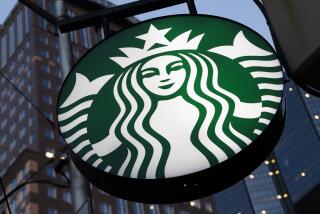Academics Are Searching for the Meaning of Starbucks
LONDON — A cup of coffee is just a drink. But a frappuccino is an experience.
So believes Bryant Simon, a historian who is searching for the meaning of modern life amid the round tables and comfy sofas of Starbucks.
Simon, who teaches at Philadelphia’s Temple University, thinks that by spending time at Starbucks -- observing the teenage couples and solitary laptop-users, the hurried office workers and busy baristas -- he can learn what it means to live and consume in the age of globalization.
“What are we drinking, and what does it say about who we are?” Simon asked during a recent research trip to London.
His research has taken him to 300 Starbucks in six countries for a caffeine-fueled opus titled “Consuming Starbucks,” due for publication in 2008. He’s one of several academics studying a type of 21st-century cafe culture -- Italian coffee in an American package -- that has spread rapidly around the world.
Founded in Seattle in 1971, Starbucks Corp. now has 11,000 outlets in 37 countries, including 500 in Tokyo. There is a Starbucks in Beijing’s Forbidden City, and the round green logo adorns the streets of Edinburgh, Scotland, and the boulevards of Paris. The company expects to open 1,800 stores this year and aims eventually to have 30,000 outlets, half of them outside the United States.
British historian Jonathan Morris says that even in Britain -- a stalwart bastion of tea drinking where there are now almost 500 Starbucks -- the chain has become entrenched in daily life. Although British coffee consumption lags far behind most other European nations, sales of “premium” coffee drinks like cappuccinos are on the rise.
“I’m not sure how much Starbucks is American anymore for British customers,” said Morris, a University of Hertfordshire professor who is leading a research project called “The Cappuccino Conquests,” about the global spread of Italian coffee.
Simon, a boyish 44-year-old whose last book, “Boardwalk of Dreams,” was a study of Atlantic City, N.J., estimates that he has spent 12 hours a week in coffee shops for more than a year.
“I try to limit myself to two to three coffees a day,” he said over a “tall” -- that is, small -- coffee at a Starbucks in London’s bustling Islington neighborhood.
Starbucks and other coffeehouses, Simon believes, fill “some kind of deep desire for connection with other people.”
But unlike the coffeehouses of 18th-century London or the bohemian java dens of 1950s New York, “Starbucks makes sure you can be alone when you’re out if you really need to be,” he said. “You get the feeling you’re out in public, but you don’t need to talk to anyone.”
Simon’s research has made him finely attuned to the many varieties of the Starbucks customer, from the twentysomething female friends at a nearby table to the middle-aged man hunched over his laptop.
“This kind of guy is renting space,” said Simon, who visited 25 Starbucks during four days in the British capital. “He bought a cup of coffee in order to have some space. These two women in front of us -- where else can women meet in urban settings?”
Starbucks Chairman Howard Schultz told shareholders at their annual meeting Feb. 8 that the company was focusing on “the Starbucks effect” -- that is, putting a bigger emphasis on music sales, movie marketing and other non-coffee products.
Simon believes that Starbucks succeeds by “selling comfort” in an anonymous, often dislocating world. He says he has lost track of the number of times people have told him that when they traveled to a strange country, “the first thing I did when I got off the plane was go to Starbucks.”
“There’s a deep sense of unpredictability in the modern world, and what Starbucks provides a lot of people is predictability,” he said.
But there are regional variations. Starbucks introduced green tea frappuccinos in Taiwan and Singapore in 2001. They proved so popular, they’re now on the U.S. menu.
Simon notes one big difference between British Starbucks and their U.S. counterparts.
“Starbucks is dirty here [in London],” he said, gesturing to a mess of used lids and stir sticks on a stained tabletop. “Americans have been taught to do part of the labor, and they clean up after themselves. In the U.S., part of Starbucks’ appeal is its cleanness.”
More to Read
Eat your way across L.A.
Get our weekly Tasting Notes newsletter for reviews, news and more.
You may occasionally receive promotional content from the Los Angeles Times.










